Shack-Hartmann - notes for occasional users
Version 0.3.
ING's Shack-Hartmann camera can be used at various WHT or INT focal stations to measure the
quality of the optics upstream of the camera. It's routinely mounted at WHT
Cassegrain (on the ACAM port) to check that M1 and M2 are aligned, and was
in Seprtember 2020 mounted behind the new WEAVE corrector to evaluate the
quality of the images delivered by the corrector optics.
These notes summarise key points for occasional observers
who may want to know the basics, but don't need the detail
provided in the
full Shack-Hartmann observing recipe.
Contents:
- Overview of the camera
- During the afternoon
- During twilight
- At night
The main components, in light-path order, are a beam-splitter (and the Basler acquisition camera,
and an artifical star), collimator,
filter, lenslet array, shutter and CCD (usually the 1k x 1k TEK2):
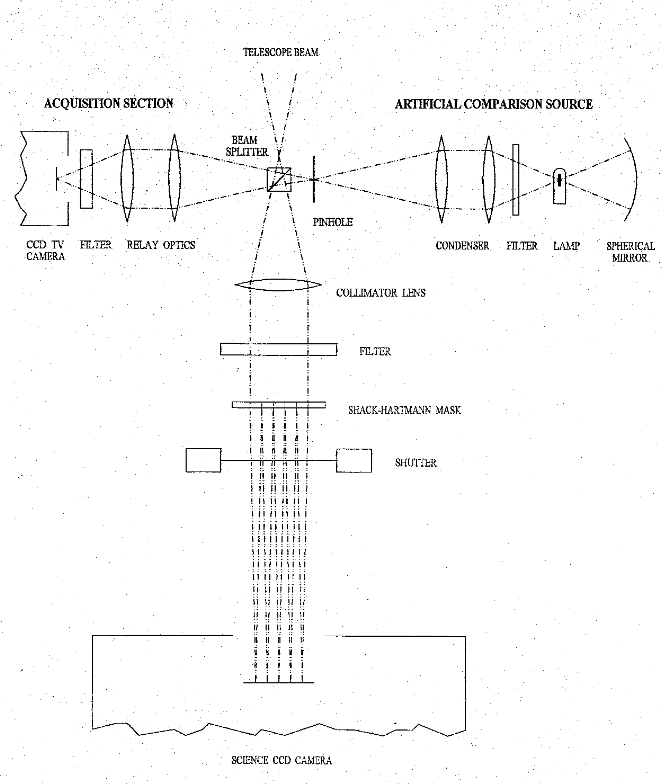
(figure taken from the
Fisher/Worswick technical manual).
The beam-splitter lies close to the telescope
focus and splits the incoming starlight, or light from the lamp (artificial star),
between the Basler acquisition camera and the main
Shack-Hartmann camera.
1.1 - Basler acquisition camera
The Basler acquisition camera comprises a (2k x 2k) CCD with a square
field of view ~ 105 x 80 arcsec (850 x 650 pixels), scale ~ 0.124 arcec/pixel.
The field of view is limited by the (5-mm) beam-splitter.
A filter (e.g. blue, matching the blue filter in the Shack-Hartmann arm)
can be inserted in front of the camera.
The Basler itself includes no optics (but is preceded by the usual optics
of the acquisition TV).
The Basler can operate
in imaging mode (with optional saving of images) or video mode.
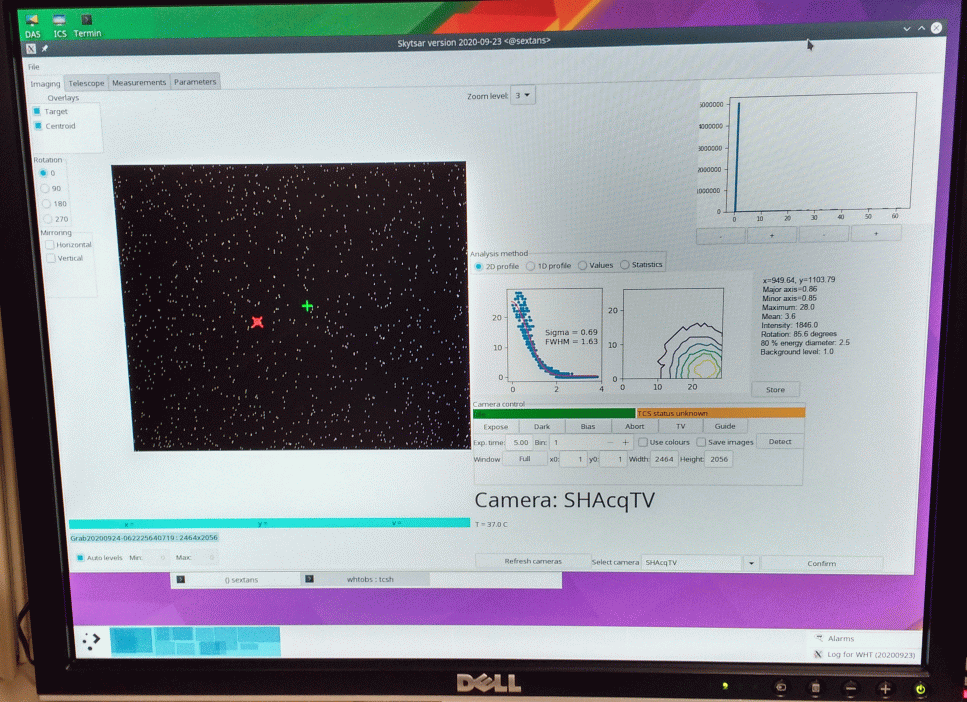
Jure's 'skytsar' interface to the Basler acquisition camera (click on image for
full size). (Photo by Cecilia Fariña)
The detector saturates at ~ 250 counts. Exposure times can be very short
(msec) but the maximum recommended exposure time is
10 sec (because of the high dark current).
10 sec is also the limit for on-chip integration; if a longer exposure time
is requested, shorter-exposure images will be summed in software.
To mark a position (e.g. that of the lamp) on the Basler screen, move the
cursor to
the required position, right click and select 'current mouse position'.
FITS copies of the images generated by the Basler are deposited in the directory where
the Basler skytsar control gui was started up.
They have names starting with 'basler'
and ending in .fit
and including a 22-digit time-stamp. The files include FITS headers and can be
read by iraf in the usual way.
The Basler acquisition camera has been installed specifically for the
WEAVE PFC/Shack-H tests in Sep 2020. It may not be available for
subsequent Shack-Hartmann observations, in which case the old analogue
TV camera may be reinstated.
1.2 - Shack-Hartmann camera
In the Shack-Hartmann arm of the camera,
the lenslet array splits the post-collimator wavefront into a square grid of ~ 20 x 20
parcels of light (each sampling a corresponding section of the main telescope mirror)
and focuses these parcels of light into a grid ~ 20 x 20 spots on the Shack-Hartmann CCD.
The star and lamp images look similar, except that on the image of the star, spots outside the area
of the main telescope mirror will not be illuminated (i.e. the spots outline an area
corresponding to mirror minus central hole):
| Star | | Lamp
|
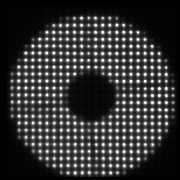
|
| 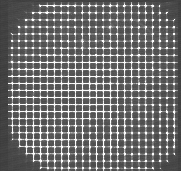
|
In the left-hand image, the shadows cast by the four vanes supporting
the secondary mirror can just be seen.
The data analysis comprises: measuring the x,y position of the few hundred spots on each
of the star and lamp images; matching each star spot with a lamp spot; calculating the dx, dy; and
fitting to these dx,dy a sum of spherical-aberration, coma and astigmatism terms (i.e. the low-order Seidel
aberrations). Each is quoted in arcsec rms, which for a 2-D gaussian
(i.e. a radially symmetric function I(x,y)) corresponds to FWHM / 1.67 or
ee80 / 2.54.
Past values can be found on the
WHT optics log.
- In the afternoon, switch on the power supply for the lamp
-
usually two small boxes left on
the desk in the control room:
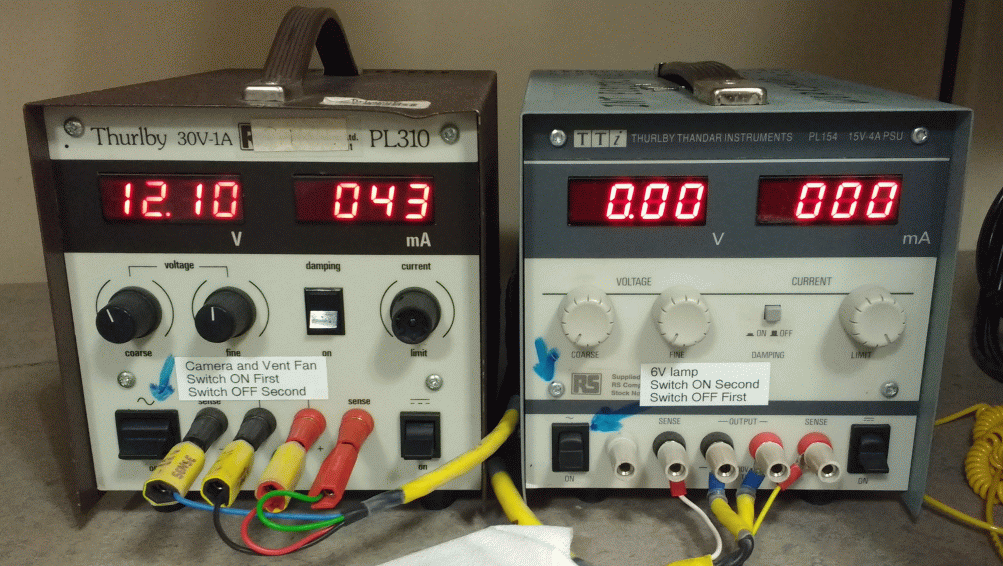
The power supply for the Shack-Hartmann acquisition unit:
fan at left, lamp at right (click on image for
full size). (Photo by Cecilia Fariña)
Both boxes must be switched on (because the TV-control box runs the
fan for the lamp).
The boxes must be switched on (or off) in the order stated on the labels
on the front.
- Set the lamp current (top right knob) to about 2.8 Amps (voltage will
be ~ 5.7 V?). As of 9/2020, we are using ~ 2 V to check
the image of the pinhole, and 4 V for a Shack-Hartmann lamp expopsure
-
Mark the position of the lamp spot on the Basler display
(this where stars should be acquired).
- Set Shack-Hartmann CCD readout speed = 'Fast', no binning, no windowing.
- Make a trial exposure with the Shack-Hartmann camera e.g.:
run tek2 1
(or, equivalently,
run testinstrument 1).
-
Determine the exposure time needed to obtain a lamp frame with
maximum counts ~ 30000 (~ 1 sec for WHT PF in 9/2020).
- Check that the distance between spots is approx 1 mm on the CCD,
which on TEK2 is ~ 42 (24-micron) pixels.
- Point the telescope to a medium-brightness star (e.g. from the pointing grid),
mag ~ 11 (brighter will saturate the Basler in exposure times long enough to
measure the seeing).
For non-WEAVE observations,
advise the telescope operator to assume INSTRUMENT = OWN, at the
telescope control system.
- Acquire the star on the Basler camera, at the position where the lamp spot
was detected.
- Focus the telescope, by minimising
the diameter of the star on the Basler.
The skytsar interface to the Basler can be configured to display
image FWHM (a Gaussian fit) and ee80 diameter (empirical), both in arcsec.
With the Shack-Hartmann camera mounted
on the Cassegrain A&G box, the focus should be ~ 97.85 (found 5/2016),
similar to that for
other Cass instruments. At prime focus, it will be
~ 88.0 mm.
For the WEAVE PFC, the focus is ~ -1.60 as of 9/2020.
- Take a test exposure (~ 10 sec) of the star with the Shack-Hartmann
camera to check that the
spots are evenly illuminated.
- Use ROT MOUNT 0. Switch tracking of rotator off.
- Determine the coordinate system on the Shack-Hartmann CCD
by offsetting the star 10 arcsec in
azimuth, then zero in azimuth, 10 in elevation (if you offset both
at once, star will be vignetted). The direction of any observed
aberrations
with respect to the mirror can then be determined by measuring the
position of any reference spot on the Shack-Hartmann image.
With the Shack-Hartmann camera mounted on the ACAM port, and
with the rotator at mount position = 0, azimuth increases to upper
right on the CCD as conventionally displayed, and elevation increases
to lower right (i.e. both at ~ 45 deg to the x,y columns).
The Shack-Hartmann observations require seeing less than 2 arcsec.
They can be carried out in moonlight (as long as the moon is not very close)
but not in bright twilight, because pisafind translates the gradient in
the background into changes in spot position.
Dust and poor transparency are not a problem, as long as sufficient
counts are obtained (criteria below).
- Acquire a bright star (mag ~< 4.5 for WHT, at the ACAM port)
at the position on
the Basler where the lamp spot appeared.
The star should be single, i.e. no other star within a few arcmin.
- The telescope should be tracking.
The rotator should be set to a
fixed mount position as above (e.g. ROT MOUNT 0) and NOT tracking.
- Take a Shack-Hartmann exposure.
Check that most of the spots are present.
- No autoguiding is possible because the mount PA is fixed.
Instead, the telescope must be hand guided, i.e. the telescope operator
should check every few minutes that the star is within 1 arcsec
of the acquisition position on the Basler. But it's better that
guiding corrections are not made
*during* an individual exposure.
- Take 2 Shack-Hartmann exposures of the star, aiming for ~ 20000 counts peak signal
(about 50 sec for star mag ~ 4, 100 sec for mag ~ 4.5).
The exposures should be long enough to average out seeing variations
(i.e. > 10 sec).
If the star has a close companion (< few 10s arcsec) the
Shack-Hartmann image will be double - switch
to another star.
- Offset the telescope ~ 5 arcmin, switch
on the lamp and take a Shack-Hartmann lamp exposure (see previous section).
Star exposures are useless without lamp exposures at the same position
of the telescope.
If the telescope is offset only a few 10s of arcsec, the lamp
exposure will be contaminated by light from the star.
- Record the seeing e.g. as measured by the RoboDIMM.


